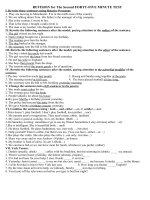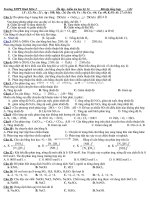BÀI TẬP LẦN 2 NGUYỄN THANH PHONG
Bạn đang xem bản rút gọn của tài liệu. Xem và tải ngay bản đầy đủ của tài liệu tại đây (219.6 KB, 4 trang )
Sinh viên: Nguyễn Thanh Phong
MSSV: G1002398
Lớp: GT10HK
KHÍ ĐÀN HỒI
Giảng viên: TS. Trần Tiến Anh
Ngày nộp: 06/03/2014
BÀI TẬP 1-4
Introduction to Structural Dynamics and Aeroelasticity
Problem 1:
Show that the equation of motion for longitudinal vibration pf a uniform beam is the same ass
that for a string, viz.
y
x
∂ 2u
∂ 2u
EA 2 = m 2
∂x
∂t
Solution:
ds
u+
∂u
∂T
dx T +
dx
∂x
∂x
u
v
dx
We have:
With β = 0
∂
∂ 2u
T =m 2
∂
x
∂t
So :
&
∂ 2v
0=m 2
∂t
Such as the force of the rod vertically then u turn stretches over time, and v is constant (the
derivative with time 0)
Equation (2.19) T = EAε
Let us presuppose the existence of a static-equilibrium solution of the string deflection so that
whereT0 and ε o are constants and δ=l−l0 is the change in the length of the string between its
stretched and unstretched states.
If the steady-state tension T0 is sufficiently high, the perturbation deflections about the staticequilibrium solution are very small. Thus, we can assume:
we find that the equations of motion can be reduced to two linear partial differential equations:
∂ 2uˆ
∂ 2uˆ
EA 2 = m 2
∂x
∂t
Problem 2:
Show that the equation of motion for longitudinal vibration pf a uniform beam is the same ass
that for a string, viz.
l
2
∂u
P = ∫ EA ÷ dx
∂x
0
Solution:
To solve problems involving the forced response of strings using Lagrange’s equation, we
need an expression for the strain energy, which is caused by extension of
the string, viz.
where, as before
and the original length is0. To pick up all of the linear terms in Lagrange’s equations, we must
include all terms in the energy up through the second power of the unknowns. Taking the
pertinent unknowns to be perturbations relative to the stretched but undeflected string, we can
again write
ForEAequal to a constant, the strain energy is:
Because
:
Strain energy simplifies to
the strain energy becomes
We assuming that v is const and ε o << 1 so we have:
l
2
∂u
P = ∫ EA ÷ dx
∂x
0
Problem 3:
Show that the equation of motion for longitudinal vibration pf a uniform beam is the same ass
that for a string, viz.
l
2
∂u
K = ∫m
÷ dx
∂t
0
Solution:
To solve problems involving the forced response of strings using Lagrange’s equation, we also
need the kinetic energy. The kinetic energy for a differential length of
string is
With:
∂v
= 0 (v is const)
∂t
so we have:
2
l
∂u 2
∂u
dK = m ÷ dx ⇒ K = ∫ m ÷ dx
∂t
0
∂t









